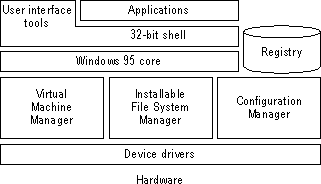Windows 95 Architecture Components
Windows 95 features a new device driver model, a new file system, a new 32-bit graphics engine, and new 32-bit print, communications, and multimedia subsystems. Windows 95 is a 32-bit operating system with built-in connectivity support. It provides high performance, robustness, and complete backward compatibility.
All of these features are supported by the modular design shown in the following diagram.

This chapter describes the key components that make up the Windows 95 architecture beginning with its central information store, the Registry, and proceeding from bottom to top.
Summary of Improvements over Windows 3.1
Although its architectural design is based on Windows version 3.1, Windows 95 includes several improvements over the earlier operating system:
- A fully integrated 32-bit, protected-mode operating system, which eliminates the need for a separate copy of MS-DOS.
- Preemptive multitasking and multithreading support, which improves system responsiveness and offers smooth background processing.
- 32-bit installable file systems including VFAT, CDFS, and network redirectors. These support better performance, use of long filenames, and an open architecture to support future growth.
- 32-bit device drivers, available throughout the system, which deliver improved performance and intelligent memory use.
- A complete 32-bit kernel, including memory management and process scheduling and management.
- Improved system-wide robustness and cleanup after an application ends or fails. This delivers a more stable and reliable operating environment.
- More dynamic environment configuration, which reduces the need for users to adjust their systems.
- Improved system capacity, which allows multiple applications and system tasks to run well concurrently.

